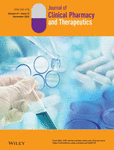The efficacy of oral corticosteroids for treatment of Tietze syndrome: A pragmatic randomized controlled trial
Abstract
What is known and objective
Tietze syndrome is a rare form of chest wall costochondritis with joint swelling which can cause significant chest pain and decline in ability of daily activities. There is no standardized treatment protocol. The aim of this study was to assess the efficacy of adding oral steroids in addition to other non- steroidal treatment in improvement of pain and quality of life (QOL) in patients with Tietze syndrome.
Methods
Forty patients with Tietze syndrome were randomly divided into two treatment groups: (1) One week of prednisolone 40 mg daily followed by 1 week of prednisolone 20 mg daily followed by 1 week of 10 mg with 3 weeks of non-steroidal anti-inflammatory drug (NSAID) treatment (n = 20); (2) three weeks of NSAID treatment only (n = 20). A symptom questionnaire was used to rate the major symptoms of Tietze syndrome and costochondritis: Numeric rating scale (NRS) for pain on a scale of 0 (no pain) to 10 (severest pain); the resulting global symptom score was used to evaluate the efficacy of treatment with assessment of joint swelling resolution. The EQ-5D-5L instrument for measurement of QOL was used. Assessments were made on intention to treat basis at baseline and at 1, 2 and 3 weeks followed by a medium term follow period after treatment cessation. The trial was registered at www.isrctn.com ISRCTN11877533.
Results and discussion
There was a significant drop in mean NRS pain scores between the groups at 1, 2 and 3 weeks in favour of the steroid group (46.8% vs. 17.7%; p < 0.001, 56.3% vs. 35.8% p < 0.001 and 65.4% vs. 46.7% p < 0.001 respectively). There was a 25.8% (95% CI 13.2–38.8) difference in mean NRS score drop at a median of 6.5 months after treatment cessation in favour of the steroid group over the NSAID only group. Only three cases of mild GIT upset in the steroid group and two cases of mild nausea were reported in the NSAID group. There was an improvement in QOL using the median EQ-5D-5L scoring at 3 weeks in favour of the steroid group 7 (7, 8) versus 10 (8.5–11), (p < 0.001). The improvement in pain scoring and QOL did not correlate with improvement in joint swelling at 3 weeks after treatment with 2/20 (10%) in the steroid arm versus 1/20 (5%) in NSAID arm having an obvious improvement (p = 0.393).
What is new and conclusion
In this study, addition of short-term oral corticosteroids showed a clear benefit for use at 1, 2 and 3 weeks in improvement of pain and QOL in patients with Tietze syndrome. This difference was maintained at mid-term follow up after treatment cessation. This facilitates the advantage of using steroids as well as excluding their side effects for an accepted timeframe.
CONFLICT OF INTEREST
The authors declare no conflicts of interest.
Open Research
DATA AVAILABILITY STATEMENT
Data is available.




